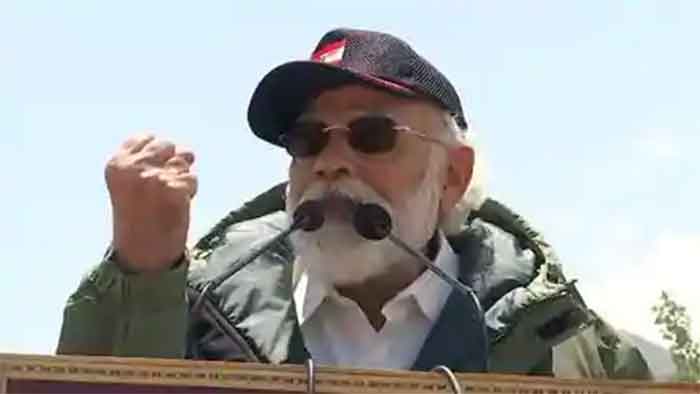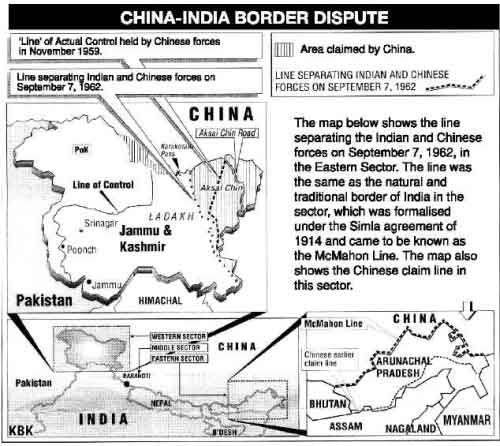
Amid India-China border standoff, Prime Minister Narendra Modi on Friday made a “surprise” visit to Leh and indirectly referred to China by saying that “the era of expansionism is over”. Making a mountain out of a molehill, the mainstream media used the occasion to indulge in an act of hero-worship. It turned blind to critical questions and concerns raised by the opposition parties and security analysts.
The next day (July 4) several newspapers joined in the chorus to sing Modi’s praises. Look at the headlines of the following Hindi newspapers. “The expansionist should not forget that such
forces get wiped out: Modi” (Vistarvadi na bhulen, aesi taqaten mit jati hain: Modi)—was the lead story of Hindustan (Delhi). The front-page headline of Dainik Jagran (National) had a similar headline. “The days of expansionism are over: Modi” (Lad gaye vistarvad ke din: Modi). The headlines of Jansatta, Amar Ujala, Dainik Bhaskar, Pioneer (all New Delhi edition) were too similar to be differentiated.
The leading English dailies, too, lauded Modi’s visit to Leh and put him at the centre of the whole affair. These headlines — “Era of expansionism is over” (The Indian Express, Delhi), “Era of expansionism is over: PM’s warning to China on Ladakh visit” (Hindustan Times, Delhi), “Age of expansionism is over: Modi sends a message to China” (The Times of India, New Delhi) — seem to be clones of one another.
The Urdu dailies also stressed Modi’s utterance of “expansionism” (tawsee pasandi). The headings of the lead stories –“The era of expansionism is over…” (Siyasat, Hyderabad: Tawsee pasandi ka daur nahin), Lets battle against expansionism in the world and battle for development (Rashtriya Sahara, Mumbai: Duniya men tawsee pasandi nhin taraqqi ki jang), “No expansionism in the world…” (Aag, Lucknow: Duniya men tawsee pasandi nahin) — seem to be a case of copy and paste.
On the same day the newspapers also penned editorials. The editorials, like the news stories, exalted Modi’s visit. Dainik Jagran (National, p. 8.) argues that Prime Minister’s surprise visit to Leh, has not only boosted the morale of the soldiers but also given a strong message to China that India would give a befitting reply to its aggressive acts. In its editorial, Hindustan (New Delhi, p. 8) says that the echo of Prime Minister Modi’s speech will continue to be felt in the world for some more time. The editorial of Dainik Bhaskar (New Delhi, p. 8.) praises Modi for visiting Leh and giving a strong message to the “enemy” that the country is ready for the war if China is reluctant to resolve the dispute peacefully.

Likewise, The Indian Express’s editorial has venerated Modi’s visit: “Prime Minister Narendra Modi’s visit to Ladakh and his address to the nation — and beyond — on Friday go significantly beyond the graded responses from New Delhi so far…The PM’s speech in Ladakh casts away any remaining ambiguity of the political response”. The editorial f Hindustan Times (New Delhi, p. 10.) has played a similar tune: “On Friday morning, Prime Minister (PM) Narendra Modi shaped India’s future foreign policy and security doctrine for years to come”.
But the Hindi news channels crossed all limits of exaggeration in praising Modi. One news channel claims that what Modi did in Leh has not been done by any leader of the world nor has any previous prime minister of India acted like Modi! Another Hindi news channel contends that Prime Minister Modi is confident about the victory over China. As a result, he is leading from the “front”. A popular Hindi news anchor does not miss the occasion to attack the opposition Congress party, particularly Gandhi family, for seeking clarification from Prime Minister Modi over the India China clash.
As is evident here, the media – with a few exceptions – has all operated within a single narrative. How could the media claim that Modi’s visit to Leh was the first act of its kind and no predecessors of his have done so? Has the media become blind to the fact that the previous Prime Ministers as well as Defence Ministers have visited the Army deployed on the borders and interacted with the Army personnel?
Moreover, the media conveniently ignored the fact that Defence Minister Rajnath Singh, not the Prime Minister, was to visit Leh. Telegraph from Kolkata, in its coverage, did raise this issue: “It was Rajnath who had been scheduled to visit Ladakh on Friday but government sources had on Thursday said the trip had been deferred”. Has not Modi’s decision to visit Leh, instead of the Defence Minister, undermined the role of his colleague in the cabinet? How far is it correct that Modi’s visit to Leh was an attempt to draw the media attention to himself and silence his critics?
Besides, Modi’s speech at Leh was no less problematic. For example, he began his speech with a chant of “Bharat Mata ki Jai” and ended with the slogans of “Bharat Mata ki Jai and Vande Matram”. Isn’t the media aware of the fact that these slogans have (Hindu) religious connotations and the religious minorities have objected to them? In a country with a secular constitution, was the Prime Minister, as the leader of the country, justified in invoking symbols of majoritarian religion before hundreds of army jawans? Even more worrisome is the fact that Modi, in his speech, invoked Hindu goddess Krishna? While giving his speech, Modi forgot that he was there as the prime minister of the country and not as the RSS pracharak.
These important points did not figure anywhere in the media coverage. Instead, the media looked eager to believe everything the Prime Minister said. At the same time, it gave almost no space to the concerns raised by the opposition parties and security analysts about the alleged mishandling of the situation by the Government that led to the skirmish between Indian and Chinese forces at the Galwan Valley on the night of June 15/16. Has the media forgotten that the opposition parties — particularly the Congress — have long been asking the Government to lift the veil over the whole incident?
The security experts have also been vocal about the government’s failure. For example, Ashok Kantha, Director of the Institute of Chinese Studies, in an interview with Karan Thapar on May 26, said that “I will not rule out an accident happening”. Lt. Gen H. S. Panag (Retired) — a day after Defence Minister Rajnath Singh confessed that the Chinese had come inside Indian territory in a large number — accused the Modi Government of being “in denial mode” after a “loss of territory”. Similarly, General Ashok K Mehta commented that “the fatal clash on the night of June 15/16 at Galwan appears to be a horrendous miscalculation that was grievously mishandled”.
Amid all this, the Prime Minister, in an all-party meeting , went against the statement of Defence Minister Rajnath Singh and security experts and claimed that there was “no Chinese incursion” or “loss of territory”.
If there was no Chinese incursion and no loss of territory, what is the relevance of Modi’s reference to “expansionism”? If the concerns of the opposition parties are “politically motivated” and “damaging” to the nation, why has the government banned the Chinese app and called it a “surgical strike”? If the security analysts are wrong in their assessment, why has the Prime Minister now invoked Lord Krishna holding a deadly weapon sudarshan chakra (the spinning discus)? By saying that Lord Krishna holding sudarshan chakra as our “ideal” (aadrash), has not Modi made a diplomatic mistake of invoking violence?
But none of these points has been incorporated or raised by the media while covering Prime Minister Modi’s visit to Leh.
In his lecture titled “Ranade, Gandhi and Jinnah”, B. R. Ambedkar, the great champion of democracy, warns against hero-worship and undue praise. As he puts it: “I am no worshipper of idols. I believe in breaking them”. Let’s hope that the Indian media pays heed to Babasaheb Ambedkar’s warning for the survival of democracy.
(Abhay Kumar is a Ph.D. from JNU. He is broadly interested in Minority and Social Justice. Earlier, he held a Post-Graduate Diploma in English Journalism from Indian Institute of Mass Communication, New Delhi and worked as a Delhi-based reporter with The Indian Express. You may write to him at [email protected])
SIGN UP FOR COUNTERCURRENTS DAILY NEWSLETTER
















































